University College, Durham
| Colleges of the University of Durham | ||||||||||||||||||||||||||||||
| University College | ||||||||||||||||||||||||||||||
 | ||||||||||||||||||||||||||||||
|
| ||||||||||||||||||||||||||||||
| Established | 1832 | |||||||||||||||||||||||||||||
| Master | David Held | |||||||||||||||||||||||||||||
| Senior Tutor | Eva Schumacher-Reid | |||||||||||||||||||||||||||||
| Undergraduates | 698 | |||||||||||||||||||||||||||||
| Postgraduates | 153 | |||||||||||||||||||||||||||||
| Motto | Non nobis solum | |||||||||||||||||||||||||||||
| Motto in English | Not for ourselves alone | |||||||||||||||||||||||||||||
| Website | ||||||||||||||||||||||||||||||
 | ||||||||||||||||||||||||||||||
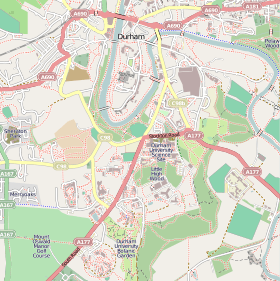
| ||||||||||||||||||||||||||||||
University College, informally known as Castle, is a college of the University of Durham in England. Centred on Durham Castle on Palace Green, it was founded in 1832 and is the oldest of Durham's colleges. As a constituent college of Durham University, it is listed as a higher education institution under section 216 of the Education Reform Act 1988.[1] Almost all academic activities, such as research and tutoring, occur at a university level.
University College moved into its current location in 1837. Around 150 students are accommodated within Durham Castle. Other college buildings, including converted 18th century houses and purpose-built accommodation from the 1950s, 1970s and 1980s, are within five minutes' walk of the castle. The college has 700 undergraduates and is currently the most over-subscribed college of the University.[2] In 1987 it admitted women undergraduates for the first time, having previously had an all-male student body.
As of January 2012 the Master of the college is political theorist David Held.
History
Early years
University College was formed upon the creation of University of Durham in 1832. It was the first college of the university, and is therefore known as the "foundation college", but the university was founded explicitly on the Oxbridge model, and the intention was already for the university to develop along collegiate lines in the manner of Oxford and Cambridge, as indeed it has.[3] Durham Castle had been the home of the Prince Bishops of Durham, and William van Mildert, one of the founders of the university, had intended for the castle to be given to the college. Temporary accommodation for students was provided at the Archdeacon's Inn (part of Cosin's Hall) on Palace Green until University College moved into its permanent home.[3] Castle moved to its current location at Durham Castle in 1837 after van Mildert's successor, Edward Maltby, completed renovations of the building.[4]
The castle's keep, formerly a ruin, was redeveloped for student accommodation; in particular, the college's chapels and Great Hall have been restored. Since then high levels of maintenance have been, and still are, necessary to preserve the buildings of the castle.

The university's second college, Hatfield Hall, was formed in 1846 as a response to the high costs of maintaining Castle. These costs arose from the students' expectations of being provided with servants and room furnishings.[5]
The university struggled for the rest of the 19th century, held back by a lack of prestige and a distance from the centres of power in the UK.[6] By 1882, Castle contained some 79 undergraduates out of 205 at the university as a whole. Despite the university largely failing to gain recognition and prestige, a number of other colleges had opened by the end of the nineteenth century. Of these, Cosin's Hall failed to become financially viable and was absorbed into University College in 1864.[6] Enrolment numbers continued to fluctuate.
1919–38
The inter-war years were transformative for Castle. The college was the smallest in Durham university, with just 34 undergraduates in 1928,[7] and was struggling to meet maintenance costs. The Castle, situated on the banks of "The Peninsula", was in danger of collapsing into the River Wear and many of its internal structures were weak. The combination of high costs and low undergraduate numbers meant that the college was often threatened with closure or merger with Hatfield.[8] Castle was saved largely through charitable donations. A visit in the 1920s from Edward, Prince of Wales (later Edward VIII), helped increase the profile of the cause.[7] In the 1920s, the castle's foundations were secured through reinforcement with concrete.[4] Following these and other extensive building refurbishments of the 1920s and 1930s the college was now able to expand.
Post-war
One of its most successful periods followed during the Second World War when personnel of the Durham University Air Squadron were posted in the castle, doing short courses before joining the Royal Air Force.[4] Those from the college who died during World War II were commemorated by the redevelopment of the Norman Gallery area of the Castle in the 1950s. This period also saw the launch of Castellum, an annual journal of the Castle Society, created to keep former students in touch with college life.[9] In order to continue this expansion, the college purchased Lumley Castle in 1946 to house students,[7] and by 1948 seventy five students were housed there. This section of the college developed a spirit of its own and is still remembered today through activities such as the Lumley Run.

During the 1950s and 1960s the college expanded through developments at Owengate and Bailey Court, both around Palace Green.[7] In the 1970s, the college sold Lumley Castle.[10] The proceeds were used to fund the development of Moatside Court, and meant that all the college's students were now housed within five minutes of the main castle. During this period there was rapid change in the size and structure of the college, which expanded to over 300 undergraduates by 1979.[7]
_-_geograph.org.uk_-_987660.jpg)
Female students were admitted to the college for the first time in 1987; until then it had been single sex.[11] Since this time the college has become fully mixed, with undergraduate numbers expanding to nearly seven hundred. Expansion caused a strain on college numbers, however, and in 2004 the college was unable to provide accommodation for all of its fresher students for the first time in its history.[12] Following the foundation of Josephine Butler, Durham's first new college to be opened since 1972, pressure from the university to take on additional students has lessened, and undergraduate numbers have been intentionally reduced in recent years.[13]
Buildings and architecture
.jpg)
Construction of Durham Castle began in 1072,[14] which makes it the oldest building in use at any University in the world.[15][16] The castle retains much of its original design and structure, and is part of a UNESCO World Heritage Site with Durham Cathedral.
The castle's northern wing originally contained a dining hall, but this was later divided up to make more luxurious quarters for the Prince Bishop.[17] This area is also home to the two chapels of the college. The Norman Chapel dates from the 11th century and is the oldest accessible part of the castle, and retains its original Saxon architectural style. The Tunstal Chapel is the larger of the two; it dates from the 15th century and is named after Cuthbert Tunstal. Both chapels are used for worship within the college.[18]
.jpg)
To the east of the courtyard lies the Keep. It was re-built in the 1830s, having previously lain in ruins. This area has the largest concentration of students living in the castle. To the south of the courtyard is the Gatehouse, built originally by Hugh de Puiset in the 12th century and re-developed in the sixteenth and eighteenth centuries.[17] Around this are the college's more modern offices.
The college's other buildings are at Moatside Court, Owengate and Bailey Court. The developments at Moatside Court and Bailey Court date from the 1960s and 1970s, whilst Owengate was formed from a series of old houses in the 1950s. Of these, Moatside Court's rooms were of a notoriously poor quality,[19] but have recently been renovated at the cost of over £1 million.
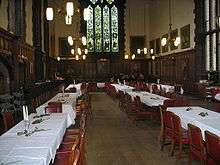
Great Hall
To the west of the courtyard is the medieval Great Hall, still used as a dining room by students and staff.[16] It was built during the time of Anthony Bek in the 13th century. For two hundred years this was the largest Great Hall in Great Britain; however, it was shortened by Richard Foxe.[17] It still stands some 14 m (46 ft) high and 30 m (98 ft) long. The black staircase that leads from the Great Hall to the Senior Common Room dates from 1662, and is another of the older sections of the college still in use.[17] Underneath the Hall is the college bar, located in an 11th-century undercroft.[20] Around these are student accommodation, the Lowe Library, and kitchens.
Lowe Library
The Lowe Library is the college's library. It was formed from a bequest from Colonel W.D.Lowe, an officer of the Durham University Officers' Training Corps. He later became a Classics tutor at the university and rowing coach for University College,[21] staying until his death in 1921.[7] The library was opened in 1925, extended into the college's wine cellar in 1997,[22] and now contains over 10,000 books. It acts as a support to the central university library, providing access to core textbooks.
Role and activities
University College is the most over-subscribed college at the university; for entry in 2006, there were 2,858 applications for just 170 places (approximately 17 applicants for every place).[13] As with all colleges at Durham, students study for degrees with Durham University, not their college, and teaching takes place in academic departments. University College is a "listed body" under the Education Reform Act (1988).[23]
Although colleges are largely concerned with welfare, leisure and accommodation, University College has been running the 'Durham Castle Lecture Series' since 2012.[24] Past and forthcoming speakers include Saskia Sassen, Gayatri Chakravorty Spivak, Rowan Williams, Anthony Giddens, Justin Welby and Martin Wolf.[24]
Within Durham's colleges, there is a strong competitive rivalry. Castle's main rival is Hatfield College, which is Durham's second oldest college, having separated from Castle in the 1850s. The rivalry is maintained by student pranks and tricks and in various intercollegiate sporting events.
The college has a commercial arm, taking advantage of the attractive nature of the college's buildings. It hosts corporate events, conferences and weddings during the university vacations.[25]
The Castle is open to tourists only via guided tours. These occur daily outside of term time, but are more restricted during the term due to potential conflicts with the running of the college. Furthermore, events in the university timetable may result in their cancellation. Tourists are not otherwise permitted entry to the college or any common areas.[26] There is relatively little conflict between students and tourists, with many of the guided tours done by students themselves.
Student body
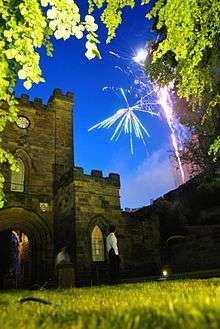
Some 700 undergraduates attend Castle, making it slightly smaller than the average Durham college. Of these students, around 100 live in the castle itself, while another 250 are housed in the college's surrounding buildings.[27] It remains the most popular college in Durham for applications, with around 23 students applying for every available place.[2]
The undergraduate student body (Junior Common Room or JCR) is governed by an elected Executive Committee headed by the Senior Man (even when a female student holds the role) and supported by several other officers. Regular JCR meetings are held to discuss and vote on important issues. There are several other elected non-executive officers such as Returning Officer, Fresher Rep and Sports Captain who organise other important college functions. The Senior Man meets regularly with college and university authorities to represent the JCR.
The JCR runs three balls every year for its students, with one held during each term. The largest is the end of year June Ball, which is the social highlight of the academic year. Tradition dictates that its theme remains closely hidden until the doors to the Castle open.[28]
The graduate community at Castle forms the Middle Common Room (MCR), which is based in the Maurice Tucker[29] (previously William de St-Calais[30]) Room. However, due to size restrictions, no members of the MCR are currently able to live in the college grounds.[31] The MCR, like the JCR, organises a number of social events and activities, such as the college's entry into the inter-collegiate University Challenge competition, which acts as trials for the University's team. The Senior Common Room (SCR), is an organisation of academics and tutors connected to the college. The SCR also organises formal meals with guest speakers.
The student bar of University College is called the Undercroft Bar (known colloquially as The Undie), due to its location in an 11th-century Undercroft. It developed from the original Junior Common Room, which opened in the early 1950s. It is currently run by the Food and Beverage Services Manager with the help of several JCR members.
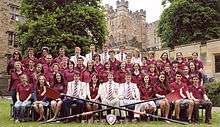
Societies
University College JCR also supports many societies run exclusively for Castle students. The most popular societies include University College Boat Club (UCBC), Castle Theatre Company, Castle Football Club and Castle Hockey Club.
There are a number of arts societies within the college. Most notable is Castle Theatre Company, which produces a play each term. These plays are usually performed on the college's grounds, although they sometimes tour nationally.[32] They have also appeared at the Edinburgh Festival Fringe.[33]
Castle Society
The Castle Society was formed in 1947 by Castle Alumni. It was originally named the Durham Castleman's Society. Membership is open to anyone with academic ties to the college, and its aim is create a wider Castle community beyond its immediate students. The society makes regular donations to the college library, chapel, student bursaries, and various college societies. It has helped fund a number of projects in the college, including the accommodation at Moatside Court and Fellows Garden, as well as the West Courtyard Common Room. The Castle Society produces the annual journal "Castellum", which chronicles life at the Castle and reports on activities of Castle alumni.[34] Since 1990, it has contributed towards the University College Durham Trust, the college's charitable fund.
Notable alumni
Castle alumni are active through organisations and events such as the two annual reunion dinners, which cater for the more than 7,000 living alumni.[35]
A number of Castle alumni have made significant contributions in the fields of government, law, science, academia, business, arts, journalism, and athletics, among others.

 Guillaume, Hereditary Grand Duke of Luxembourg, heir apparent to the crown of Luxembourg since his father's accession in 2000.
Guillaume, Hereditary Grand Duke of Luxembourg, heir apparent to the crown of Luxembourg since his father's accession in 2000.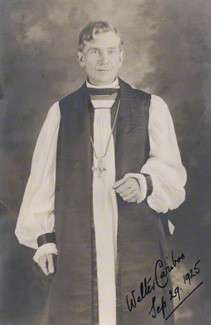 Walter Adams, Archbishop of Yukon.
Walter Adams, Archbishop of Yukon.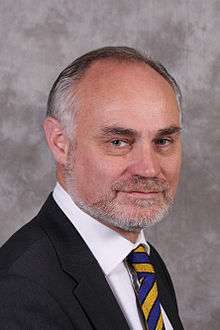 Crispin Blunt, Conservative MP for Reigate, Surrey.
Crispin Blunt, Conservative MP for Reigate, Surrey. Edward Bradley, clergyman and novelist.
Edward Bradley, clergyman and novelist.- Jackie Doyle-Price, Conservative MP for Thurrock.
 Sir Harold Evans, journalist and writer who was editor of The Sunday Times from 1967 to 1981.
Sir Harold Evans, journalist and writer who was editor of The Sunday Times from 1967 to 1981. Helen Grace, English actress.
Helen Grace, English actress. Piers Merchant was a British Conservative Party politician.
Piers Merchant was a British Conservative Party politician. Stephen Warner, one of Britain’s leading evangelists, and rector of Holy Trinity, Eastbourne.
Stephen Warner, one of Britain’s leading evangelists, and rector of Holy Trinity, Eastbourne. James Wharton, Conservative MP for Stockton South.
James Wharton, Conservative MP for Stockton South.
| Name | Degree (Graduated) | Career | Ref |
|---|---|---|---|
| Guillaume, Hereditary Grand Duke of Luxembourg | Hereditary Grand Duke of Luxembourg | ||
| Walter Adams | Mathematics | Former Archbishop of Yukon (1947-1952) | |
| Crispin Blunt | Politics (1984) | Conservative MP and Parliamentary Under-Secretary of State in the Ministry of Justice | [36] |
| Edward Bradley | Novelist and clergyman known by the pen-name Cuthbert M. Bede | ||
| George Malcolm Brown | Geology (1950) | Fellow of the Royal Society, former Director of the British Geological Survey | [37] |
| Professor Tim Crane | Philosophy (1984) | Philosopher | [38] |
| Hunter Davies | Arts | Author, journalist and broadcaster | [39] |
| Jackie Doyle-Price | Economics | Conservative MP for Thurrock and Member of the Public Accounts Committee | |
| George Entwistle | Philosophy and Politics (1983) | Journalist, TV producer and former Director-General of the BBC | [40] |
| Harold Evans | BA Politics and Economics, MA | Journalist, writer and former editor of The Sunday Times | [41] |
| Christopher Foster | Bishop of Portsmouth | [42] | |
| Phil de Glanville | Economics (1990) | Former captain of the England national rugby union team | [43] |
| Sir James Goss | Law (1974) | Justice of the High Court (Queen's Bench Division) | [44] |
| Helen Grace | Psychology (1992) | Actress | |
| William Greenwell | BA (1839), MA Theology (1843) | Fellow of the Royal Society, archaeologist, bursar of Castle (1844-1847), canon at Durham Cathedral | [45] |
| George Hills | The first bishop of the Diocese of British Columbia | [45] | |
| Robert Hornby | BA (1841), LTh (1842), MA, BD (1852), DD (1856) |
Antiquarian and priest at York Minster | [45] |
| Walsham How | first Bishop of Wakefield | [45] | |
| Simon Hughes | BA | Writer, cricket analyst and former Middlesex and Durham bowler | |
| Tim Laurence | BSc Geography | Husband of Princess Anne and son-in-law of Elizabeth II | [46] |
| Edward Leigh | History | Conservative MP for Gainsborough and Chairman of the Public Accounts Committee | |
| Rachel McCarthy | Physics and Chemistry | Scientist, poet, critic and broadcaster | |
| Piers Merchant | Former MP for Newcastle upon Tyne Central and "Senior Man" of the college JCR | [47] | |
| Gareth Sibson | Law | Writer and broadcaster | |
| Joseph Stevenson | Catholic archivist | ||
| Henry Villiers-Stuart | Soldier, clergyman, author and Liberal Member of Parliament for County Waterford | [48] | |
| Stephen Warner | Classics | Rector of Holy Trinity, Eastbourne | |
| James Wharton | Law | Solicitor and the youngest Conservative MP in the House of Commons (MP for Stockton South), elected 2010) | [49] |
| Robert Beckley QPM | Police service | Chief Constable and Chief Operating Officer of the College of Policing. (Former Senior man and president of the Students Union) |
List of masters
The college is run by a "Master", the most senior position in the SCR. As the first master of University College, Archdeacon Charles Thorp, also held the post of university warden. Following Thorp's death in 1862 the mastership was created as a separate position, and has been held by thirteen people:[7]
- Charles Thorp 1832–1862
- Joseph Waite 1865–1873
- Herbert Booth 1873–1875
- Alfred Plummer 1875–1902
- Henry Gee 1902–1919
- Henry Ellershaw 1919–1930
- J. H. How 1930–1939
- Angus Macfarlane-Grieve 1939–1954
- Len Slater 1954–1973
- D. W. McDowall 1973–1978
- Edward Salthouse 1979–1998
- Maurice Tucker 1998–2011
- Eva Schumacher-Reid 2011 (Acting Master)
- David Held 2012–present
Gallery
 The Keep of Durham Castle - where some students are accommodated - as seen from the street.
The Keep of Durham Castle - where some students are accommodated - as seen from the street. The main entrance to the College from the courtyard.
The main entrance to the College from the courtyard. University College as seen from Durham Cathedral in winter.
University College as seen from Durham Cathedral in winter.- Aerial view of the College.
 The 11th century undercroft as seen in the late 19th century - it is now used as the College bar area.
The 11th century undercroft as seen in the late 19th century - it is now used as the College bar area.- Durham Gatehouse, the main entrance to the College from Palace Green.
 Houses in Owengate, the oldest of which dates back to the 16th century. They are now used as student accommodation.
Houses in Owengate, the oldest of which dates back to the 16th century. They are now used as student accommodation. Panorama view of Palace Green, showing Durham Cathedral to the left, the old University Library in centre, and University College and Owengate to the right.
Panorama view of Palace Green, showing Durham Cathedral to the left, the old University Library in centre, and University College and Owengate to the right.
References
- ↑ Department for Children, Skills and Families. "Listed Bodies Search". Archived from the original on 26 September 2007. Retrieved 19 October 2007.
- 1 2 Durham University (21 February 2006). "Facts and Figures". Retrieved 7 August 2006.
- 1 2 Durham University (17 January 2005). "Foundation of Durham University". Archived from the original on 17 June 2006. Retrieved 7 August 2006.
- 1 2 3 Durham University (14 February 2006). "History of the Castle". Retrieved 7 August 2006.
- ↑ Hatfield College (23 January 2006). "History of the College". Durham University. Archived from the original on 3 June 2006. Retrieved 7 August 2006.
- 1 2 Whiting, Charles Edwin (1932). The University of Durham. London: Sheldon Press. ISBN 0-8223-2340-0.
- 1 2 3 4 5 6 7 Jones, Edgar (1996). University College, Durham: A Social History. Aberystwyth: Edgar Jones. ISBN 0-9528264-0-2.
- ↑ Darwin, K (1948). "The Junior Common Room, University College, Durham". Castellum. 1: 11–14.
- ↑ Chase, F.S.M. (1948). "Editorial". Castellum. 1: 1–11.
- ↑ No Ordinary Hotels (2006). "Our History". Retrieved 11 January 2007.
- ↑ University College (12 April 2006). "Castle Society". Retrieved 10 August 2006.
- ↑ Tucker, Maurice (2004). "Letter From the Master – October 2004". Castellum. 57: 2–5.
- 1 2 Hajibagheri, Sarah; Purser, Emily (23 October 2006). "Fresher intake upsets the balance". Palatinate. p. 2.
- ↑ Durham City Tourism. "Things to see and do in the City of Durham – Durham Castle". Retrieved 30 December 2006.
- ↑ McCall, Alastair (2 October 2005). "Widening access without diluting quality". London: The Sunday Times. Retrieved 7 August 2006.
- 1 2 University College JCR. "For Prospective Students". Retrieved 7 August 2006.
- 1 2 3 4 Simpson, David (2006). "Durham Castle". North East England History. Retrieved 7 November 2006.
- ↑ University College chapels. "History, Chapels of University College, Durham". Retrieved 13 December 2010. College Chapels Retrieved December 2010
- ↑ Macleod, Donald; Berrow, Heather (15 January 2002). "Dark days". The Guardian. London. Retrieved 11 October 2006.
- ↑ The Undercroft Bar (2006). "Home – about the Undie". Archived from the original on 15 March 2007. Retrieved 7 August 2006.
- ↑ Macfarlane-Grieve, Captain A.A., ed. (1922). A History of Durham Rowing. Newcastle-upon-Tyne: Andrew Ried and Company, Limited.
- ↑ Hollier, John (1997). "Lowe Library Project". Castellum. 49: 27–30.
- ↑ Department for Education and Skills (2005). "A-Z of Colleges, halls and institutions of a University, University of Durham". Archived from the original on 9 December 2006. Retrieved 9 November 2006.
- 1 2 "Durham Castle Lecture Series". Durham University. Retrieved 25 October 2013.
- ↑ University College (24 November 2006). "Conferences and Tourism". Retrieved 20 December 2006.
- ↑ Ross, David; Britain Express. "Durham Castle". Retrieved 9 November 2006.
- ↑ Durham University (2004). "Undergraduate Student Accommodation – Full Time" (PDF). Retrieved 9 October 2006.
- ↑ University College JCR Social Chairman; June Ball Committee. "The June Ball". Retrieved 7 August 2006.
- ↑ http://www.dur.ac.uk/castle.mcr/tucker.html
- ↑ http://www.dur.ac.uk/castle.mcr/calais.html
- ↑ Nawroyckyi, Nick (2006). "Information for Prospective Postgraduates". University College MCR. Retrieved 8 October 2006.
- ↑ Castle Theatre Company (2006). "As You Like It". Retrieved 19 October 2006.
- ↑ Castle Theatre Company (2006). "Young Macbeth". Retrieved 19 October 2006.
- ↑ Castle Society (12 July 2006). "Castellum". Durham University. Retrieved 7 August 2006.
- ↑ "The Durham Difference" (PDF). Durham University. Retrieved 2009-04-03.
- ↑ BBC NEWS (2001). "Crispin Blunt". Retrieved 20 December 2006.
- ↑ Dunham, Kingsley; Holland, Granville (4 April 1997). "Obituary: Professor Sir Malcolm Brown". The Independent. London. Retrieved 12 March 2011.
- ↑ "Professor Tim Crane | Peterhouse Cambridge". www.pet.cam.ac.uk. Retrieved 2016-10-11.
- ↑ Cross, Peter (24 January 1999). "Working life: The secret of my success – Hunter Davies". The Independent. Retrieved 20 December 2006.
- ↑ "Durham alumnus becomes new BBC Director General". Durham Newswire. September 2012.
- ↑ University College. "University College, College Officers" (PDF). University College Calendar. Retrieved 20 December 2006.
- ↑ Who's Who 2008: London, A & C Black ISBN 978-0-7136-8555-8
- ↑ Durham University (6 June 2000). "Cricket and Rugby captains honoured in Durham's top sporting awards". Archived from the original on 25 April 2005. Retrieved 20 December 2006.
- ↑ ‘GOSS, James Richard William’, Who's Who 2014, A & C Black, an imprint of Bloomsbury Publishing plc, 2014
- 1 2 3 4 Fowler, J. T. "Durham University; earlier foundations and present colleges" (PDF). pp. 150–169. Retrieved 09/06/2013. Check date values in:
|access-date=(help) - ↑ "Alumni in the Armed Forces". Durham University. Retrieved 14 March 2009.
- ↑ Durham Union Society (2006). "Friday 13 October" (PDF). Termcard, Epiphany Term 2006. Archived from the original (PDF) on 5 December 2006. Retrieved 20 December 2006.
- ↑ https://archive.org/stream/debrettshouseo1881londuoft#page/216/mode/2up/search/durham/
- ↑ "James Wharton MP: About Me". James Wharton MP. Retrieved 12 March 2011.
External links
| Wikimedia Commons has media related to University College, Durham. |
- University College official website
- University College JCR undergraduate student organisation
- University College MCR postgraduate student organisation
- University College SCR staff organisation
